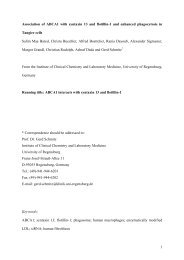SUNDAY, DECEMBER 4- Late Abstracts 1 - Molecular Biology of the ...
SUNDAY, DECEMBER 4- Late Abstracts 1 - Molecular Biology of the ...
SUNDAY, DECEMBER 4- Late Abstracts 1 - Molecular Biology of the ...
Create successful ePaper yourself
Turn your PDF publications into a flip-book with our unique Google optimized e-Paper software.
<strong>SUNDAY</strong><br />
cGKII was increased in SHR ileum and colon as compared to WKY controls. Captopril treatment<br />
<strong>of</strong> SHR caused a partial reversal <strong>of</strong> <strong>the</strong>se changes, and a significant reversal <strong>of</strong> NHERF-1.<br />
These changes do not seem to be due to any difference in <strong>the</strong> microsomal protein yield. We<br />
demonstrate evidence <strong>of</strong> mild inflammation in SHR colon and ileum due to hypertension. Our<br />
findings showed decreased expression <strong>of</strong> NHE-1, -3 and NHERF-1, which toge<strong>the</strong>r would<br />
suppress uptake <strong>of</strong> water and NaCl from <strong>the</strong> GI-tract and hence may be a counteracting<br />
response in <strong>the</strong> development <strong>of</strong> hypertension in this model.<br />
Acknowledgments: Kuwait University Research administration (grant YM 06/2010) and College<br />
<strong>of</strong> Graduate Studies for financial support and Shared Core Facility, Health Science Center,<br />
Kuwait University for allowing to use <strong>the</strong> instrumentation.<br />
2010<br />
Gustatory receptors not G protein coupled receptors are required for <strong>the</strong> response to Lcanavanine.<br />
Y. Lee 1 , M. Kang 2 , J. Shim 3 , C. Cheong 2 , S. Moon 2 , C. Montell 1 ; 1 Department <strong>of</strong> Biological<br />
Chemistry and Neuroscience, Center for Sensory <strong>Biology</strong>, The Johns Hopkins University School<br />
<strong>of</strong> Medicine, 2 Department <strong>of</strong> Oral <strong>Biology</strong>, Brain Korea21 project, Yonsei University College <strong>of</strong><br />
Dentistry, Seoul, Korea, 3 Department <strong>of</strong> Phamacology, Yonsei University College <strong>of</strong> Medicine,<br />
Seoul, Korea<br />
Insects respond to <strong>the</strong>ir surroundings through sensing chemical cues and <strong>the</strong>n decide <strong>the</strong>ir<br />
behaviors. Gustatory sense is one <strong>of</strong> <strong>the</strong> most important chemical sensory systems. There are<br />
68 gustatory receptors (GRs) encoded by 60 gustatory receptor genes. Several gustatory<br />
receptors are known to be required for sensing <strong>of</strong> sugars or bitter chemicals, such as caffeine.<br />
However, <strong>the</strong> functions <strong>of</strong> most GRs are unknown. Here we show that Gr8a and Gr66a are<br />
required for sensing insecticide, L-canavainine, which is produced by plants. Gr8a is expressed<br />
in a subset <strong>of</strong> Gr66a expressing gustatory receptor neurons (GRNs). The action potentials to Lcanavanine<br />
are detected only in <strong>the</strong> Gr8a expressing neuron. The consistence <strong>of</strong> Gr8a<br />
expression pattern and electrophysiological response to L-canavanine suggests <strong>the</strong> possibility<br />
that Gr8a is <strong>the</strong> specific receptor to L-canavanine, while Gr66a is <strong>the</strong> broad receptor to bitter<br />
chemicals. In contrast, DmXR, one <strong>of</strong> <strong>the</strong> G-protein coupled receptors (GPCRs), has been<br />
reported to be required for detecting L-canavanine. However, DmXR missing flies show <strong>the</strong><br />
avoidance to L-canavanine and action potentials to L-canavanine as wild type flies do in our<br />
results. These results imply that Gr8a and Gr66a are indispensible for detection <strong>of</strong> Lcanavanine,<br />
but not DmXR.<br />
2011<br />
NHERF- 1 Modulates Intestinal NaPi transporter NaPi-2b expression in Apical Microvilli.<br />
H. Giral 1 , Y. Caldas 1 , L. Lanzano 2 , E. Gratton 2 , M. Levi 1 ; 1 University <strong>of</strong> Colorado Denver, Aurora,<br />
CO, 2 University <strong>of</strong> California Irvine, CA<br />
The regulation <strong>of</strong> phosphate (Pi) homeostasis is maintained by <strong>the</strong> coordinated function <strong>of</strong> <strong>the</strong> renal and<br />
intestinal phosphate transporters. Several PDZ (PSD-95/discs large/ZO-1 homologous) domain<br />
proteins, including NHERF-1, PDZK1, ShanK2, and PIST play an important role in <strong>the</strong> regulation <strong>of</strong> <strong>the</strong><br />
renal sodium-phosphate (NaPi) co-transporters (NaPi-2a and NaPi-2c). The main mediator <strong>of</strong> intestinal<br />
sodium dependent transcellular Pi transport, NaPi-2b, also contains a PDZ-binding motif consensus in<br />
<strong>the</strong> C-terminal region. However, interactions <strong>of</strong> <strong>the</strong> transporter NaPi-2b with PDZ proteins have been<br />
not described and <strong>the</strong>ir potential role in regulation <strong>of</strong> <strong>the</strong> intestinal transporter is not known. For this<br />
purpose we performed studies with knock-out (KO) mice models and cell culture to determine a<br />
potential role for NHERF-1 and PDZK1 in <strong>the</strong> regulation <strong>of</strong> NaPi-2b.
















